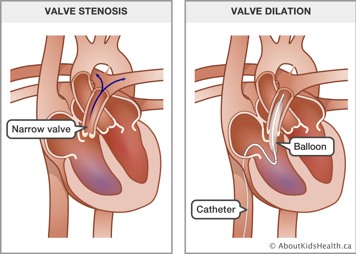What is a heart valve?
Heart valves are like gates that control the flow of blood between the upper and lower chambers of the heart, as well as the flow out of the heart.
There are four heart valves:
- the tricuspid valve, between the right atrium and the right ventricle
- the mitral valve, between the left atrium and the left ventricle
- the pulmonary valve, between the right ventricle and the pulmonary artery
- the aortic valve, between the left ventricle and the aorta
If the opening of a valve is too narrow, the heart cannot pump blood through it easily. A narrow valve is called stenotic.
What is a valve dilation?
A valve dilation is done to open a heart valve that is abnormally narrow. A valve dilation is also called a balloon valvotomy.
A valve dilation can be done on any heart valve. The procedure is done in the heart catheterization laboratory.

What is heart catheterization?
During heart catheterization, the doctor carefully puts a long, thin tube called a catheter into a vein or artery in your child's neck or groin. The groin is the area at the top of the leg. Then, the catheter is threaded through the vein or artery to your child's heart.
The doctor who does the procedure is a cardiologist, which means a doctor who works on the heart and blood vessels. This may not be your child's regular cardiologist.
To learn about heart catheterization, please see Heart catheterization: Getting ready for the procedure.
There are small risks of complications from the procedure
Generally, cardiac catheterization is a fairly low-risk procedure, but it is not risk-free. The doctor will explain the risks of cardiac catheterization to you in more detail before you give your consent for the procedure. The most common risks are:
The catheter may break through a blood vessel
There is a very small risk that the catheter may break through a blood vessel or the heart wall. To reduce this risk, we use a type of X-ray called fluoroscopy to see where the catheters are at all times.
More common complications occur with dilations of the pulmonary and aortic valves.
Complications from pulmonary valve dilations
The pulmonary valve controls the flow of blood from the heart to the pulmonary artery, which carries blood to the lungs. This valve often becomes leaky after a valve dilation. This condition is called valve incompetence. It is usually mild and can occur after surgical valvotomy as well.
Some valves do not improve enough with a valve dilation and may need surgery.
Complications from aortic valve dilations
The aortic valve controls the flow of blood from the heart to the aorta, which carries blood to the body. When this valve is too narrow, the pressure in the heart is too high and the heart has to work too hard to pump blood. However, if the valve is expanded to get rid of all the narrowing, it will probably leak. The goal of aortic valve dilation is to make the narrowing just wide enough to reduce the pressure in the heart to safe levels, without causing a significant leak.
The doctor chooses a balloon that is small enough that it will not get rid of all the narrowing. Then surgery can be avoided. In 2% to 3% of cases, the valve becomes very leaky, even when the right-sized balloon is used. If this happens, your child may need surgery to repair the valve.
For general information about the risks of heart catheterization, please see Heart catheterization: Getting ready for the procedure.
What happens during the procedure
The procedure is performed while your child is under a general anaesthetic. This means that your child will be asleep during the procedure.
During the catheterization, the doctor threads a special catheter through your child's blood vessels to the valve. The team takes X-ray pictures and measurements of the valve. Then the team threads a deflated balloon on the tip of the catheter to the narrowed valve. The balloon is then inflated to open up the narrowed valve. Sometimes a second larger balloon is used to dilate the area further.
Then the balloon is deflated. The doctor takes out the balloon and catheter, and covers the cuts on your child's leg with a bandage.
The procedure will take two to four hours
The procedure usually takes two to four hours. After the procedure, your child will go to the recovery room to wake up from the anaesthetic.
After the procedure
Your child will probably need to spend the night in hospital after the procedure. If your child needs to spend the night, they will be transferred to the inpatient unit from the recovery room.
The cardiologist will let you know when your child can go home and when you should bring your child back for a check-up.
For information on what to do after your child goes home, please see Heart catheterization: Caring for your child after the procedure.
Coming back for a check-up
Your child will be given a date and time to see their cardiologist after the procedure.
Write the date and time of the appointment here:
Antibiotics to prevent infectious endocarditis
Depending on your child's specific heart condition, your child may need to take antibiotics before and after some dental and other procedures. These drugs help prevent a heart infection called infectious endocarditis. Speak to your cardiologist for more information.